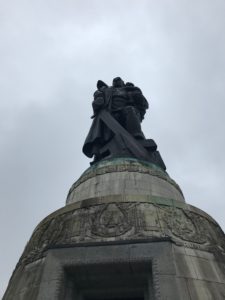Multifaceted Remembrance of Communism–The Good and the Bad
By Luke Burke
Soviet domination of Eastern and Central Europe stretched so far across so many borders for a majority of the 20th century, thus its place in the identity of nations affected by it can never be discounted or forgotten. With that being said, how are places like Poland and East Germany, heavily impacted and subjugated by the Soviet sphere of influence until the fall of communism, supposed to remember the role in which Communism and the USSR has played in its past?
Soviet-backed communist regimes lasted for so long in Central Europe and for that reason remembrance is so multifaceted and complex in how it manifests itself through the decades since the fall of communism. One can note positive achievements of the Soviet era, but we are not able to turn our backs to the atrocities that occurred in this period. This reality that the Soviet Union has done positive things while also committing crimes against humanity leads to very difficult and nuanced attitudes towards the USSR today, meaning many people of Central and Eastern Europe struggle with how they should look back upon the time under Soviet influence. Through all the Soviet Union has done, there seems to be a very complicated give and take, a condemnation, but also a recognition for not only the successes, but also the stability of the era.
This complex relationship with the Soviet past is evident in Poland. In August of 1939 German Foreign Minister Ribbentrop and Soviet Commissar Molotov signed a nonaggression pact, which divided Poland into two spheres of influence. On September 1st 1939, Germany invaded the western half of Poland. War was declared on Germany by Great Britain and France, although no actual aide or fighting force was created to come to Poland’s assistance. On September 17th, the Soviet Union invaded from the east. Poland that was nowhere near ready to withstand this invasion and officially fell on September 27th. This would result in its complete disappearance off the map until the end of the war. Poland would be in a fight to regain its independence from outside influence until 1989.
 According to an article written by Ellen Hinsey called Death in a Forest, immediately following the Soviet invasion almost 250,000 Poles were taken as prisoners and deported east into the Soviet Union or its surrounding territories by the People’s Commissariat of Internal Affairs (NKVD). Among these people were high ranking military officers and professors, artists, and journalists working as noncommissioned officers–all considered as threats to the new communist order. A large portion of officers were transported to POW camps in the USSR. The told roughly 20,000 officers sent to the camps were executed and buried in mass graves, including one in the Katyn Forest. According to Hinsey, in a document signed by Joseph Stalin himself, these people were considered “irremediable enemies of the Soviet Union”.
According to an article written by Ellen Hinsey called Death in a Forest, immediately following the Soviet invasion almost 250,000 Poles were taken as prisoners and deported east into the Soviet Union or its surrounding territories by the People’s Commissariat of Internal Affairs (NKVD). Among these people were high ranking military officers and professors, artists, and journalists working as noncommissioned officers–all considered as threats to the new communist order. A large portion of officers were transported to POW camps in the USSR. The told roughly 20,000 officers sent to the camps were executed and buried in mass graves, including one in the Katyn Forest. According to Hinsey, in a document signed by Joseph Stalin himself, these people were considered “irremediable enemies of the Soviet Union”.
In 1943 Germans found the mass graves in Katyn, and the event perpetrated by the USSR against Poland has been deemed the Katyn Massacre.
 The Soviet Union denied responsibility for the massacre of the Polish prisoners of war and tried to blame it on the Germans to sway the minds of the shocked wartime Polish and international public. Hinsey reports that only until 1990 after a newfound government transparency program was set in place called glasnost by Mikhail Gorbachev did the USSR present to President Wojciech Jaruzelski of Poland a small amount of the NKVD’s paperwork regarding transferring the officers. In 1992, after the fall of the USSR, Russian President Boris Yeltsin gave President Lech Walesa more documents confirming the USSR’s involvement in the massacre. Some Russians still openly blame Germany. Up until then this destruction of an entire class of people that could have been leaders in the postwar period was something the Poles could not even discuss and could not mourn in the communist era.
The Soviet Union denied responsibility for the massacre of the Polish prisoners of war and tried to blame it on the Germans to sway the minds of the shocked wartime Polish and international public. Hinsey reports that only until 1990 after a newfound government transparency program was set in place called glasnost by Mikhail Gorbachev did the USSR present to President Wojciech Jaruzelski of Poland a small amount of the NKVD’s paperwork regarding transferring the officers. In 1992, after the fall of the USSR, Russian President Boris Yeltsin gave President Lech Walesa more documents confirming the USSR’s involvement in the massacre. Some Russians still openly blame Germany. Up until then this destruction of an entire class of people that could have been leaders in the postwar period was something the Poles could not even discuss and could not mourn in the communist era.
In 2010 the Polish president along with 95 other important people in Polish government and society died in a plane crash attempting to go to a service in Katyn for the victims, making greater rips at the wound of this location to Poles. Some conspiracy theories point to Russia having something to do with it, but most experts agree the air disaster was due to the intense fog which reduced visibility causing the pilots to miss the runway while attempting to land the plane.
These two events haunt Polish society. Katyn has caused great distrust in politics and society for Russia, and widespread anger toward the Soviet Union. To Poles, Katyn stands symbolically for all the crimes perpetrated by the totalitarian regime. For many citizens, this massacre has created a sense of animosity for the Soviet Union. In the 1980s Poland rallied under the Solidarity movement looking toward the west for democratic, non-authoritarian ideals as well as a free market economy. Some Polish political parties such as the ruling Law and Justice hold animosity towards Russia for its crimes, and they use the Katyn history as a way to trigger Polish nationalist support for their party. Law and Justice tries to use Katyn as a way to push their agenda that Poland can only trust itself, and no outsiders, thus furthering the growing nationalist identity of Poland. Many Poles are then led to believe cooperating with Russia in the future may be a bad idea. Poles will never forgive the USSR for what its leaders did to their people, no matter what the Polish sentiment is towards Russia today.
On the contrary, many Poles have not forgotten the Soviet Union’s role in liberating the country at the end of WWII. It was the Red Army that liberated the concentration camps on Polish soil and ended the Nazi occupation, which had cost the lives of six million citizens. Many Poles recognize the price paid by the Soviet Union in WWII, in which an estimated 23 million Soviet soldiers and civilians lost their lives, according to the BBC. Seeing the Red Army would be a beacon of hope for the Poles–Germany was deliberately destroying Poland. After the Warsaw Uprising in 1944, where, according to the city of Warsaw’s website, 180,000 civilians were executed, the Nazis literally flattened around 80% of the Polish capital, taking down with it centuries of history, culture, and any prospects of survival there. The lives lost fighting for Poland by the USSR is seen as heroic and commendable by Poles, and this part of history is something that only strengthens the remembrance. USSR war memorials are still fought for to stay erect, and Polish people have trouble turning their backs on the teenage boys that walked into battle for the greater good of Poland–to help people they have never met.
The recognition of the Soviet Union’s sacrifice to defeat the Nazis is not just in Poland. It can also be seen in Germany. A few weeks ago our group travelled to Berlin and we visited Treptower Park in the center of the city. Most of the park is taken up by the Soviet War Memorial built in 1949 designed by a Soviet architect. It is an enormous memorial and cemetery commemorating those Soviet soldiers lost in the Battle of Berlin, which took place in April and May of 1945 and cost a total of 80,000 Soviet troops. On May 2nd the Soviets claimed the German capital city and less than a week later Germany surrendered ending WW2 in Europe.
 As you enter the park you walk under a huge stone archway which has statements in both German and Russian regarding the heroism of those who fought. Then you walk down the beautiful pathway lined with trees to a statue of a grieving woman, most likely illuminating the sacrifice and hardship of all Soviet people that had to deal with sons, husbands, and brothers killed. You then take a right turn and walk through two red structures which are actually red Soviet flags at half staff. At that point you have a view of the cemetery wherein seven thousand soldiers who died in the battle are buried. Slabs of stone with reliefs of scenes of battle and Soviet success surround the mass graves. Looking over the park is a statue of a Soviet soldier with a child in one hand and a sword in the other. He has just cut in half a swastika and is resting his foot atop it.
As you enter the park you walk under a huge stone archway which has statements in both German and Russian regarding the heroism of those who fought. Then you walk down the beautiful pathway lined with trees to a statue of a grieving woman, most likely illuminating the sacrifice and hardship of all Soviet people that had to deal with sons, husbands, and brothers killed. You then take a right turn and walk through two red structures which are actually red Soviet flags at half staff. At that point you have a view of the cemetery wherein seven thousand soldiers who died in the battle are buried. Slabs of stone with reliefs of scenes of battle and Soviet success surround the mass graves. Looking over the park is a statue of a Soviet soldier with a child in one hand and a sword in the other. He has just cut in half a swastika and is resting his foot atop it.
The monument is also tied to postwar history. It was built in 1949 at the beginning of the Soviet-influenced German Democratic Republic in what used to be East Berlin. For some East Germans and Germans it is not just a memorial, because 1949 was the start of their subjugation to 40 years of a Soviet-influence and the memorial is a manifested way in which the Soviet Union forced its way into the land of Germany after the war.
Germany today acknowledges that the Soviet Union came to their capital not not only to die fighting for their own country and bring the collapse of Nazi rule, but also extend its domination into East Germany. The positive interpretation of the Soviet Union winning the Battle of Berlin and freeing the people from Nazi Germany can be seen in a speech by Richard Von Weizsacker at the ceremony commemorating the 40th anniversary of the end of WW2. He says May 8th (end of WW2) was a day of “liberation”, and that Germany may “look back with gratitude” for the Soviet Union’s struggle in WW2 and in the Battle of Berlin.
 These words about liberation are important. These words also show postwar history. They show that the people of Germany today recognized that the Soviet Union brought Germany to a better place after the war, regardless of the later domination over East Germany. These words express the attitude that no matter what happened after, the Soviet Union helped Germany get away from National Socialism. The usage of “liberation” says that this Soviet action is a positive aspect in the Soviet-German historical relationship and shall always be remembered as such.
These words about liberation are important. These words also show postwar history. They show that the people of Germany today recognized that the Soviet Union brought Germany to a better place after the war, regardless of the later domination over East Germany. These words express the attitude that no matter what happened after, the Soviet Union helped Germany get away from National Socialism. The usage of “liberation” says that this Soviet action is a positive aspect in the Soviet-German historical relationship and shall always be remembered as such.
Despite liberation, after the war people in the new East Germany had to live in a totalitarian country dominated by the USSR. Once again the people found themselves in a police state. Beginning in 1949 the German Democratic Republic was formed and a once unified Germany was split into East and West. Berlin was within the territory of the GDR, the capital city was also split in half into East and West. The West enjoyed a free democratic society, but the East was a puppet of the Soviet Union. Freedom of speech, press, and religion were immediately stripped away. The GDR enforced communism economic policies and saw their privatized industries collectivized and taken over by the government. The East German government portrayed the west as the enemy and prohibited leaving. Simply telling citizens they could not leave was not effective enough, though, as they could pass into the west rather easily at the start. In 1961in Berlin, the government started to surround West Berlin with barbed wire to stop people from escaping. This proved to be ineffective as people jumped over it. It was in that same year that the first attempt at a border wall was built in East Germany. According to our tour guide in Berlin, the wall stretched a total of 155km throughout East Germany. The wall is famously referred to as the Berlin Wall. As the years went on the government would fortify the wall even more as people would figure out new ways of escaping the regime. Eventually, in Berlin, there would be two walls and an area in the middle for guardtowers. The walls were painted white so it would be easy to detect people, and guards were permitted to kill people trying to leave. There were underground tunnels, some scaled the walls, some drove trucks through the wall. Just at the wall in Berlin 80 people were killed attempting to flee, as we saw at the monument there. Trying to leave East Germany legally was incredibly difficult, and many would use fake passports saying they were from the west. The border wall represented the terrors of communism. It famously fell in 1989.
 Society was in fear and at any moment one could be taken away and imprisoned. Who took civilians? The GDR had one of the most repressive state secret police agencies the world has seen, called the Ministry for State Security, or Stasi. This government apparatus was established in 1950 and was responsible for spying on the public and creating files documenting everything about a “suspect”. The files could be thousands of pages long. The surveillance and intimidation was unlimited. According to Timothy Garton Ash in The File, people would have their phones wire tapped, have luggage secretly checked, have spies follow suspects abroad, infiltrate churches, and even store someone’s smell in their database in case they needed to find them with a bloodhound. The Stasi were professional spies and could trail anyone using an array of different disguises.
Society was in fear and at any moment one could be taken away and imprisoned. Who took civilians? The GDR had one of the most repressive state secret police agencies the world has seen, called the Ministry for State Security, or Stasi. This government apparatus was established in 1950 and was responsible for spying on the public and creating files documenting everything about a “suspect”. The files could be thousands of pages long. The surveillance and intimidation was unlimited. According to Timothy Garton Ash in The File, people would have their phones wire tapped, have luggage secretly checked, have spies follow suspects abroad, infiltrate churches, and even store someone’s smell in their database in case they needed to find them with a bloodhound. The Stasi were professional spies and could trail anyone using an array of different disguises.
The Stasi would take people all over East Germany for minute suspicions or absurd accusations that these people were acting against the state. Our group visited a Stasi prison in former East Berlin. Prisoners were held there without knowing why, they were tortured, and many were killed. Our guide at the Stasi prison told us that in the 1950s physical torture was more common, such as standing in darkness with water up to one’s ankles for 16 hours straight without being able to speak or shift weight or rest against a wall. Prisoners would do this in small rooms which were completely packed with prisoners. In the 1970s was when psychological torture was more widely used. Interrogators would pick apart at people’s minds and use information from a prisoner’s family as a weapon. Stasi interrogators were psychologists, they were so well trained in how to make someone go mad into confessing to a crime. The Stasi was disbanded in 1990 with the fall of the GDR and many agents were then put on trial.
This East German reality is something that terrifies the people of Germany today and will never be forgotten. It further complicated their remembrance of the USSR and how they view them today. The Soviets may have come to save them from the Nazis, but the Soviets then inflicted their own atrocities onto these people.
As one can see, places like Poland and Germany have a very dense and nuanced past with the USSR in their time influenced by them. How these two countries are to remember the Soviet Union today is still highly contentious.
Sources:
- https://www.bundespraesident.de/SharedDocs/Downloads/DE/Reden/2015/02/150202-RvW-Rede-8-Mai-1985-englisch.pdf?__blob=publicationFile
- https://www.um.warszawa.pl/en/articles/history?page=0,2
- http://www.bbc.co.uk/history/worldwars/wwtwo/berlin_01.shtml
- Ellen Hinsey, Poland’s Illiberal Challenge
- Hinsey, Death in the Forest
- Timothy Garton Ash, The File



